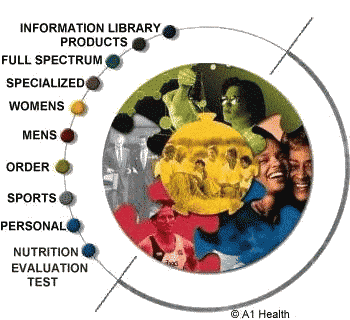COLLOIDAL MINERALS
SELENIUM, HEPATITIS B, AND LIVER CANCER
What is the use and function of SELENIUM ?SELENIUM LIVER CANCER
SELENIUM IMPORTANCE:SELENIUM LIVER CANCER
A major antioxidant nutrient, protects cell membranes and prevents free radical
generation thereby decreasing the risk of cancer and disease of the heart
and blood vessels.SELENIUM, HEPATITIS B, AND
LIVER CANCER
Selenium (Se) is an essential trace element that functions as
a component of enzymes involved in antioxidant protection and thyroid hormone
metabolism. In several intra- and extra-cellular glutathioine peroxidases
and iodothyronine 5'-deiodinases, selenium is located at the active centers
as the selenoamino acid, selenocysteine (SeCYS). At least two other proteins
of unknown function also contain SeCYS. Although SeCYS is an important dietary
form, it is not directly incorporated into these specific selenium-proteins;
instead, a co-translational process yields tRNA-bound SeCYS. In contrast,
selenium as seleno-methionine is incorporated non-specifically into many proteins,
as it competes with methionine in general protein synthesis. Therefore, tissues
often contain both specific, as well as the nonspecific, selenium-containing
proteins when both SeCYS and selenomethionine are consumed, as found in many
foods.SELENIUM, HEPATITIS B, AND LIVER CANCER
SELENIUM LIVER CANCER Medical surveys
show that increased selenium intake decreases the risk of breast, colon, lung
and prostate cancer. Selenium also preserves tissue elasticity; slows down
the aging and hardening of tissues through oxidation; helps in the treatment
and prevention of dandruff.SELENIUM LIVER
CANCER
DEFICIENCY SYMPTOMS:SELENIUM LIVER CANCER
May result in premature aging, heart disease, dandruff, loose skin.
SELENIUM LIVER CANCER
Selenium deprivation reduces activities of the selenium-dependent peroxidases
and deiodinases. The signs in animals depend upon vitamin E status and appear
only when both nutrients are limiting. They vary according to species. For
example, selenium- and vitamin E-deficient animals show myopathies of skeletal
(e.g., sheep, cow, horse), cardiac (pig) or smooth (dog, cow) muscle; hepatic
necrosis (rat, pig); increased capillary permeability (chicken); or pancreatic
acinar degeneration (chicken). Characteristic signs of selenium deficiency
have not been described in humans, but very low selenium status is a factor
in the etiologies of a juvenile cardiomyopathy (Keshan Disease) and a chondrodystrophy
(Kaschin-Beck Disease) that occur in selenium-deficient regions of China.SELENIUM LIVER CANCER
Toxicity: Selenium toxicity is characterized by dermatologic lesions;
selenotic animals and humans develop brittle hair and nails/hooves. Sporadic
cases of selenium-poisoning have been reported involving industrial or accidental
exposures to selenium-compounds. In certain rural Chinese communities chronic
intakes of very high amounts (several milligrams per day) of selenium were
linked to skin, hair and nail abnormalities which disappeared upon resuming
regular selenium intakes. Selenium has been identified as the cause of birth
deformities in migratory wildfowl in a wetland area (Kesteron Reservoir, CA)
which receives selenium-enriched irrigation wastewater. This case involved
the biological amplification of selenium by aquatic plants which were important
in the diets of affected animals.SELENIUM
LIVER CANCER
Diet recommendations:SELENIUM LIVER
CANCER
The Recommended Dietary Allowances are: 0-0.5 years, 10 µg; 0.5-1.0 years,
15 µg; 1-6 years, 20 µg; 7-10 years, 30 µg; males, 11-14 years, 40 µg; females,
11-14 years, 45 µg; males and females 15-18 years, 50 µg; adult males 70 µg;
adult females, 55 µg; pregnant females, 65 µg; and lactating females, 75 µg.
SELENIUM LIVER CANCER
|
U.S. RDA FOR SELENIUM
|
babies:
birth to 6 months
6 months to 1 year |
10 mcg per day
15 mcg per day |
children:
1 to 6 years
7 to 10 years |
20 mcg per day
30 mcg per day |
men and boys:
11 to 14 years
15 to 18 years
19 to 51+ years |
40 mcg per day
50 mcg per day
70 mcg per day |
women and girls:
11 to 14 years
15 to 18 years
19 to 51+ years |
45 mcg per day
50 mcg per day
55 mcg per day |
| pregnant women |
65 mcg per day |
| nursing mothers |
75 mcg per day |
Food sources:SELENIUM LIVER CANCER
The most important sources in American diets are meats, fish and grains. Additionally,
some foods such as Brazil nuts can have relatively high selenium concentrations.
Foods of low protein content, including most fruits and vegetables, do not
provide substantial amounts of selenium. Food selenium appears to be absorbed
with efficiencies of 60-80%; the greatest factor affecting the utilization
of food selenium is its chemical form.SELENIUM
LIVER CANCER
Recent research: Anti-tumorigenic effects of high levels of selenium
have been demonstrated in several animal models. The mechanism(s) of anti-tumorigenic
effects of selenium and the possible role of selenium in affecting the risk
of human cancer are not clear.
For further information:
Burk, R.F., ed. (1994) Selenium in Biology and Human Health. Springer-Verlag,
New York, NY
Combs, G.F., Jr. (1994) Essentiality and toxicity of selenium: a critique
of the Recommended Dietary Allowances and the Reference Dose. In: Risk Assessment
of Essential Elements (Mertz, C., Abernathy, C. & Olin, S.S., eds.), pp. 167-183.
International Life Sciences Institute Press, Washington, DC.
RELATED ARTICLES:
 SELENIUM JAMA: 12/24/96 SELENIUM MAY HELP PREVENT
CERTAIN TYPES OF CANCER SELENIUM JAMA: 12/24/96 SELENIUM MAY HELP PREVENT
CERTAIN TYPES OF CANCER
 JNCI: 4/2/97 NEW SELENIUM FORMS MAY ALLOW HIGHER DOSING JNCI: 4/2/97 NEW SELENIUM FORMS MAY ALLOW HIGHER DOSING
 SELENIUM, HEPATITIS B, AND LIVER CANCER SELENIUM, HEPATITIS B, AND LIVER CANCER
 LIBRARY LIBRARY
PREVIOUS PAGE
Beta-Carotene
 REQUEST YOUR FREE EAGLE PRODUCT INFORMATION PACK: INFOPACK@eagle-min.com REQUEST YOUR FREE EAGLE PRODUCT INFORMATION PACK: INFOPACK@eagle-min.com

INDEPENDENT
SupraLife Distributor
For personal service Call:
A1 Health
TOLL FREE ORDER EXPRESS HOT LINE :888-441-4184
9 AM Till 7PM EST
 e-mail: info@colloidal-min.com e-mail: info@colloidal-min.com
|
